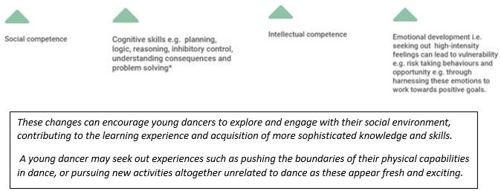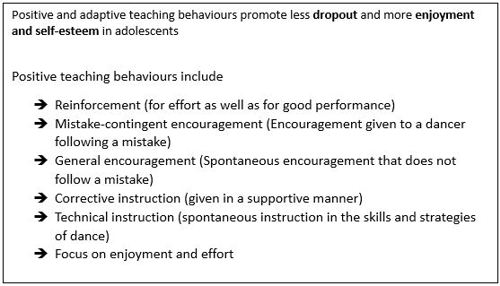Psychological perspectives on puberty in dance
Author: Siobhan Mitchell on behalf of the IADMS Dance Educators’ Committee
Following on from our busy season of Regional Meetings in Australia, USA and UK, the focus of much of our discussions at these events was on how we work with children and young people to optimize their training. Siobhan presented her session at the Healthier Dancer Day on The Adolescent Dancer in Ipswich in May 2017. Here follows one of two posts, focused on the psychological perspectives of puberty when working with young dancers. Watch out for our forthcoming post which will focus on the physiological aspects too.
As someone who works with young dancers, you will observe noticeable changes in how children think, feel, and react to others as they enter puberty. You will also see differences in what motivates and interests them. The physical changes of puberty make up just one set of changes which take place during adolescence. Cognitive, social and emotional competencies are developed across adolescence and have significant implications for training.
So what are the processes and what exactly is going on for young people at this time?
Two key areas of development are taking place: cognitive and emotional. Cognitive development describes how a person perceives and rationalises things. Cognitive development is related to age and experience rather than physical maturation. Emotional development is associated with increases in desire for specific types of emotional experience, particularly arousal and excitement.
Benefits and challenges
These developments bring both benefits and challenges for young dancers.
Benefits include
- Marked cognitive development and enhanced functioning; (optimal developmental stage for teaching & learning)
- Heightened emotional reactivity and sensitivity; greater self-awareness and social interest
- Activation of new motivational tendencies (i.e., greater desire to seek out social goals and rewards)

Young dancers must contend with these basic adaptations within a context which subjects them to amplified risk. In particular, disparity in timing between physical and cognitive development can create vulnerability for the young dancer.

Challenges include
- Heightened emotional reactivity and sensitivity; greater social sensitivity, self-consciousness and social anxieties
- Greater risk for the development affective disorders, especially those associated with the body and athletic performance (e.g., body dysmorphic disorders & eating disorders)
- Potential for reduced participation in physical activity e.g. changes in body size and shape may deter girls from participating - Dropout can be greater in contexts such as dance where there can be pressure to conform to a particular size and shape and to adapt quickly to physical changes
Top tips for negotiating some of these challenges
- Avoid the use of comments which compare one student to another
- Reduce the use of or focus on the mirror to help students to minimize comparison with others
- Be flexible about uniform during this time. This may be of particular benefit to young dancers who mature in advance of their peers and are adjusting to a changing body.
- Cues and comments focus on positive messages and how movements feel as opposed to what the body should look like
- Create a protective environment using direct and indirect actions such as reducing use of mirrors and guiding dancer aspirations toward appropriate dance pathways for example, encouraging engagement with different styles of dance or towards the creation of dance.

Siobhan trained as a dancer before going on to complete a BA Hons in Dance Studies at the University of Roehampton, an MSc in Dance Science at Trinity Laban Conservatoire of Music and Dance and an MRes in Health and Wellbeing at the University of Bath. Awarded a full ESRC studentship in 2014, Siobhan is currently in the final year of her PhD studies at the University of Bath. Her research interests are in growth and maturation, specifically, psychosocial implications of differing maturity timing in young dancers. Siobhan works as an associate lecturer and also delivers educational sessions for dancers and dance teachers on the topic of growth and maturation. Siobhan has been a member of IADMS since 2011, has been on the IADMS student committee since 2014 and is the current Student Committee Chair. Siobhan has presented at a number of international conferences including IADMS Conferences in Seattle and Pittsburgh, the IADMS regional meeting in Ipswich, the Royal Academy of Dance Conference ‘Dance Teaching for the 21st Century: Practice and Innovation’ in Sydney, Australia and the British Psychological Society Qualitative Methods in Psychology Conference, Aberystwyth, UK. Siobhan has published work in academic journals including the Journal of Adolescence and the Journal of Sports Sciences and was recently shortlisted as a finalist for the Ede and Ravenscroft prize for best postgraduate research student at the University of Bath.
Additional Video Resources
TED Talk by Sarah-Jayne Blakemore: The mysterious workings of the adolescent brain
Key References
Brooks-Gunn, J., & Warren, M. P. (1985). The effects of delayed menarche in different contexts – dance and non-dance students. Journal of Youth and Adolescence, 14(4), 285-300. doi:10.1007/bf02089235
Dahl, R. (2004). Adolescent brain development: A period of vulnerabilities and opportunities - Keynote address. Adolescent Brain Development: Vulnerabilities And Opportunities, 1021, 1-22. doi: 10.1196/annals.1308.001
Hamilton, L. H., Hamilton, W. G., Warren, M. P., Keller, K., & Molnar, M. (1997). Factors contributing to the attrition rate in elite ballet students. Journal of dance medicine & science : official publication of the International Association for Dance Medicine & Science, 1(4), 131-139.
Malina, R. M., Bouchard, C., & Bar-Or, O. (2004). Growth, Maturation and Physical Activity (Second Edition ed.). Champaign, IL: Human Kinetics.
Mitchell, S., Haase, A., Malina, R. M., & Cumming, S. P. (2016). The role of puberty in the making and breaking of young ballet dancers: Perspectives of dance teachers. Journal of Adolescence, 47, 81-89.
Smoll, F., & Smith, R. (2002). Coaching behavior research and intervention in youth sports. Children and youth in sport: A biopsychosocial perspective, 2, 211-234.
Walker, I. J., Nordin-Bates, S. M., & Redding, E. (2012). A Mixed Methods Investigation of Dropout among Talented Young Dancers: Findings from the UK Centres for Advanced Training. Journal of Dance Medicine & Science, 16, 65-73.